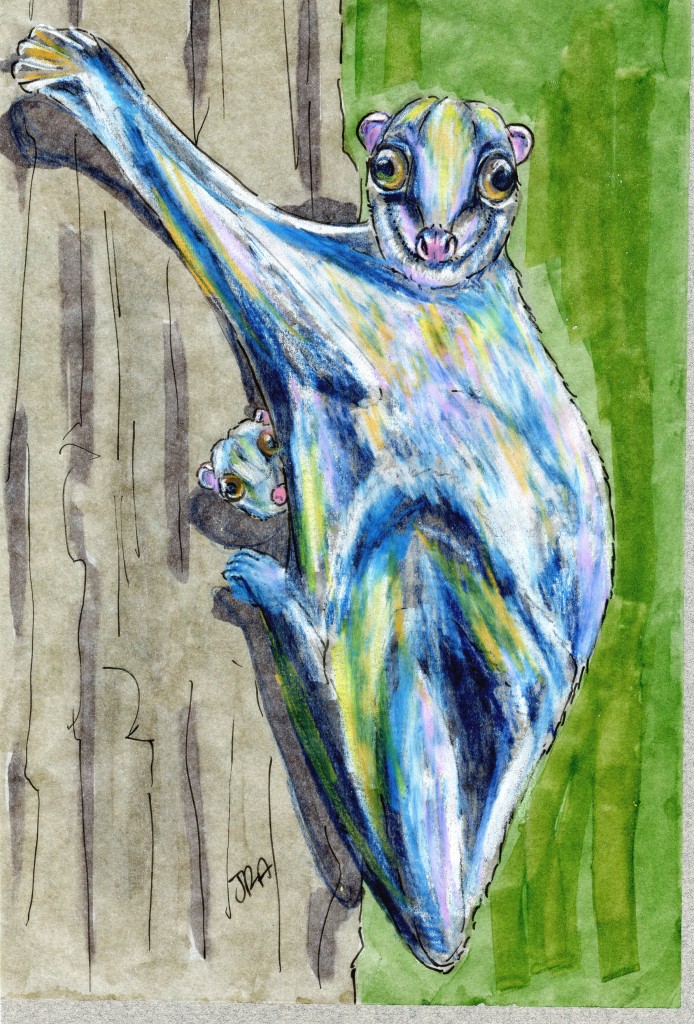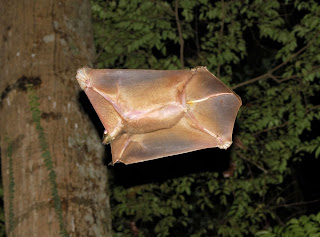Philippine Flying Lemur (Colugo) (Cynocephalus volans)
Here’s another order checked off the list. I think this is a goal we’ll reach, mammals! And what a mammal this one is. Have you ever heard of flying lemurs, also called colugos? There are two species, one that lives in the Philippines and one that lives in Thailand, Malaysia, Sumatra, Java, Borneo, and the like. Both species have this amazing membrane that stretches from their neck…to the tips of their fingers…to the tips of their toes…to the tip of their tail. Compare that to the flying squirrel, who has skin for gliding just between, basically, its wrists and ankles. It’s amazing, this colugo membrane.
Colugos flip their tail up, sort of inside out, when they’re on the go so it doesn’t get “soiled,” according to Walker’s Mammals of the World, or caught on a branch. They’re truly arboreal, and they freak out if they somehow end up on the ground. They can climb in “a series of lurches” and they shuttle along horizontal branches hanging the way sloths do. But their most impressive mode of locomotion is their gliding. In a single glide, they can travel upwards of 100 meters (109 yards)!
These guys eat almost nothing but greenery. Walker’s also says that “the gliding membrane of the mother can be folded into a soft, warm pouch to hold the young,” and “the mother may leave the young in a nest tree or carry it with her while foraging,” as you see this lady colugo doing. And colugos are crepuscular, a lovely word meaning “active at twilight.” I wonder if there’s an equivalent word that means “active at dawn.”
Finally, please click to enlarge this photograph of a colugo in flight, which is from Pennsylvania State University. It’s so amazing!
The Daily Telegraph: ‘Your cousin, the ‘flying lemur'”
Consecutive days of mammals: 16
Previous record: 11



Hi – firstly a great concept and fantastic write up around the mammal theme
Great blog! Keep up the good work
What a strange, but interesting creature. How do you find all these mammals? Do you have a list that you are going through or randomly locate them?
Thank you, Rahul and Ahmad! I’m glad you like the site! I’m going to scan and post a new mammal tonight, so come back!
Jeanette, good question. I have a lot of mammal books, the best being Walker’s Mammals of the World. Sometimes I flip through my books until a mammal catches my eye. I try not to only draw ones I know and like. Sometimes, like with this flying lemur and the next six mammals I’m posting, I’m trying to cover specific species; in this case, I wanted to be sure I’d drawn a mammal from every order in my first year of drawing mammals. And that’s where the list comes in: a spreadsheet I downloaded from the Smithsonian’s mammal department that lists the scientific names of all the known mammals. I was able to sort it by order and see which I hadn’t drawn yet. You can download my spreadsheet from the link in the post just after this one.
nice blog!^^
please also include it’s classification.
(kingdom, phylum, class, order, family, genus, species)
thanks!